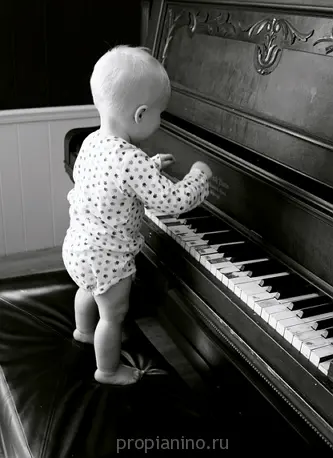
Correct seating at the piano
 As you know, a good foundation is the basis for the fact that the whole structure will be stable. In the case of the piano, this foundation will be the correct landing at the piano, because even if you know the whole theory well, you simply cannot reveal your full potential due to physical difficulties.
As you know, a good foundation is the basis for the fact that the whole structure will be stable. In the case of the piano, this foundation will be the correct landing at the piano, because even if you know the whole theory well, you simply cannot reveal your full potential due to physical difficulties.
Initially, it may seem to you that playing in the proposed way is inconvenient, but, believe me, all this was not invented for the sake of someone’s stupid whim – over time, you will realize that playing correctly is much easier than the way it comes into your head. It’s all about self-control and nothing more.
Before you start studying musical terms and definitions when going through the lessons of our Tutorial, remember these fairly simple rules – most importantly, do not be embarrassed that there are quite a lot of them:
1) Correct seating at the piano:
- A) support on the legs;
- B) straight back;
- C) dropped shoulders.
2) Support Elbows: they should not interfere with your game, the whole weight of the hand should go to the fingertips. Imagine that you have a balloon under your arms.
3) Hand movements should be free, smooth, no sudden jerks should be allowed. Try to imagine that you seem to be swimming under water.
There is another very effective way for people with strong nerves: put a coin of any denomination on your hands: when you play, they should lie flat on them, if the coin fell, then you jerked your hand too sharply or the position of the hand is wrong.
4) Fingers should be closer to black keys.
5) Press the keys pads fingers.
6) Fingers should not bend.
7) Keep your fingers together, you need them to be assembled.
 After performing each sound, hang your hand in the air, relieving tension in your hand.
After performing each sound, hang your hand in the air, relieving tension in your hand.
9) Round all the fingers during the game (as they explain to the children – put your fingers in a “house”).
10) Use the whole arm, from the very shoulder. Look how professional pianists play – they raise their hands so imposingly when they play music, not for the sake of shocking.
11) Lean on your fingertips – you need to feel the entire weight of your own hand on them.
12) Play smoothly: the brush should not “push out” sounds, they should smoothly move from one to another (the so-called “legato”).
By playing the piano correctly, you yourself will notice that your hand feels less tired, and your lessons have become much more effective.
When playing scales, sometimes divert your attention from the notes and follow your own movements: if you notice an error in the placement of your hands, or that you are sitting bent over in three deaths, then immediately correct yourself.
In this case, I still recommend asking knowledgeable people to accompany you at the first stage, or better, to help you put your hand – if you immediately start playing incorrectly and continue to do so for a long time, then it will be much more difficult to relearn, than if all the foundations had been laid in due time.
And don’t forget control!




